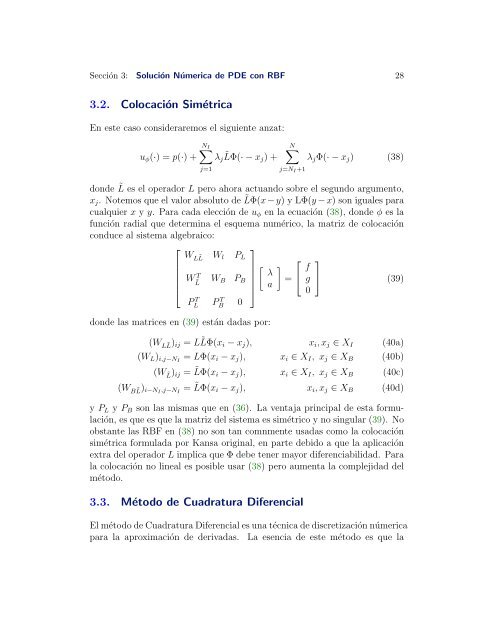Introducción a la teoría de Funciones Radiales - UNAM
Introducción a la teoría de Funciones Radiales - UNAM
Introducción a la teoría de Funciones Radiales - UNAM
Create successful ePaper yourself
Turn your PDF publications into a flip-book with our unique Google optimized e-Paper software.
Sección 3: Solución Númerica <strong>de</strong> PDE con RBF 28<br />
3.2. Colocación Simétrica<br />
En este caso consi<strong>de</strong>raremos el siguiente anzat:<br />
NI <br />
uφ(·) = p(·) + λj ˜ LΦ(· − xj) +<br />
j=1<br />
N<br />
j=NI+1<br />
λjΦ(· − xj) (38)<br />
don<strong>de</strong> ˜ L es el operador L pero ahora actuando sobre el segundo argumento,<br />
xj. Notemos que el valor absoluto <strong>de</strong> ˜ LΦ(x − y) y LΦ(y − x) son iguales para<br />
cualquier x y y. Para cada elección <strong>de</strong> uφ en <strong>la</strong> ecuación (38), don<strong>de</strong> φ es <strong>la</strong><br />
función radial que <strong>de</strong>termina el esquema numérico, <strong>la</strong> matriz <strong>de</strong> colocación<br />
conduce al sistema algebraico:<br />
⎡<br />
⎤<br />
⎢<br />
⎣<br />
W L ˜ L Wl PL<br />
W T ˜ L WB PB<br />
P T L P T B 0<br />
⎥ <br />
⎥ λ<br />
⎥<br />
⎦ a<br />
don<strong>de</strong> <strong>la</strong>s matrices en (39) están dadas por:<br />
⎡<br />
<br />
= ⎣<br />
f<br />
g<br />
0<br />
⎤<br />
⎦ (39)<br />
(W L ˜ L )ij = L ˜ LΦ(xi − xj), xi, xj ∈ XI (40a)<br />
(WL)i,j−NI = LΦ(xi − xj), xi ∈ XI, xj ∈ XB (40b)<br />
(W ˜ L )ij = ˜ LΦ(xi − xj), xi ∈ XI, xj ∈ XB (40c)<br />
(W B ˜ L )i−NI,j−NI = ˜ LΦ(xi − xj), xi, xj ∈ XB (40d)<br />
y PL y PB son <strong>la</strong>s mismas que en (36). La ventaja principal <strong>de</strong> esta formu<strong>la</strong>ción,<br />
es que es que <strong>la</strong> matriz <strong>de</strong>l sistema es simétrico y no singu<strong>la</strong>r (39). No<br />
obstante <strong>la</strong>s RBF en (38) no son tan comnmente usadas como <strong>la</strong> colocación<br />
simétrica formu<strong>la</strong>da por Kansa original, en parte <strong>de</strong>bido a que <strong>la</strong> aplicación<br />
extra <strong>de</strong>l operador L implica que Φ <strong>de</strong>be tener mayor diferenciabilidad. Para<br />
<strong>la</strong> colocación no lineal es posible usar (38) pero aumenta <strong>la</strong> complejidad <strong>de</strong>l<br />
método.<br />
3.3. Método <strong>de</strong> Cuadratura Diferencial<br />
El método <strong>de</strong> Cuadratura Diferencial es una técnica <strong>de</strong> discretización númerica<br />
para <strong>la</strong> aproximación <strong>de</strong> <strong>de</strong>rivadas. La esencia <strong>de</strong> este método es que <strong>la</strong>


